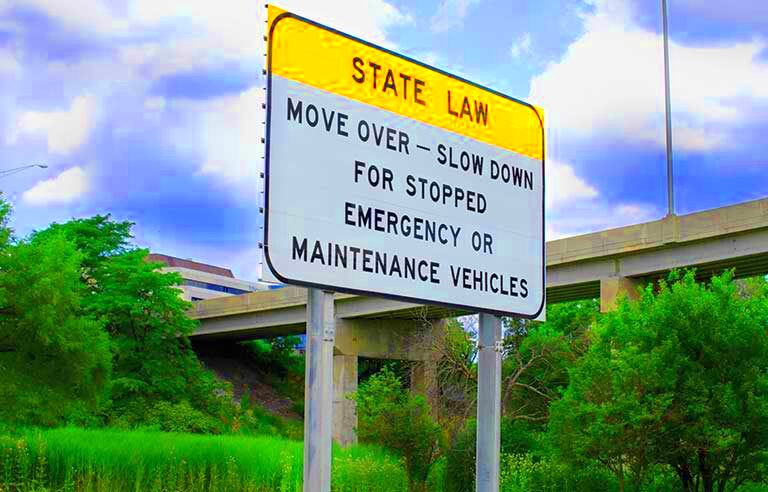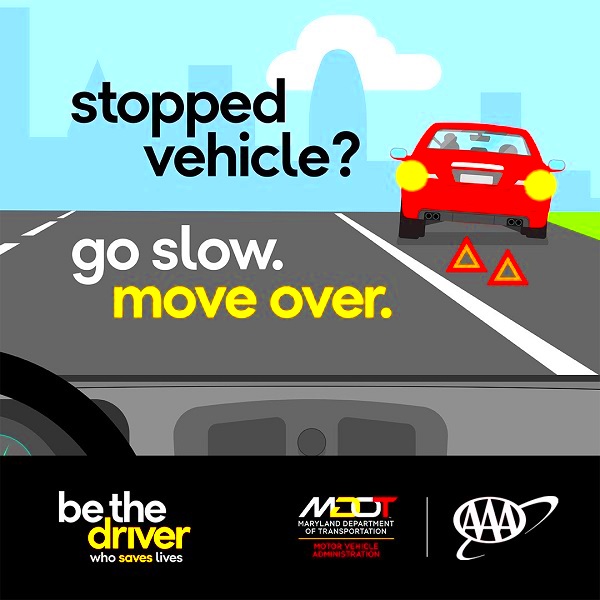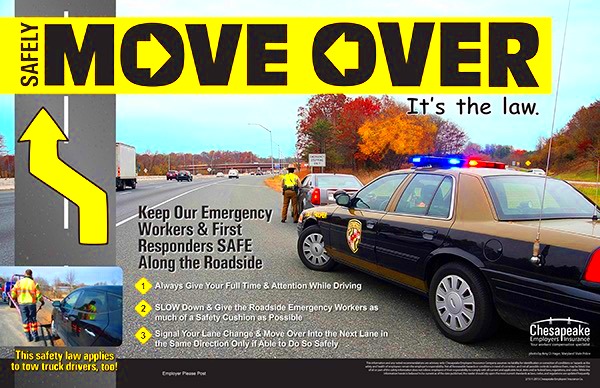Maryland Move Over Law and Its Importance for Drivers
The Maryland Move Over Law is designed to enhance safety for emergency responders and roadside workers. This law requires drivers to change lanes or slow down when approaching stationary emergency vehicles that have their lights flashing. It’s a simple yet vital measure aimed at reducing accidents and protecting those who serve on our roads. Understanding this law is crucial for all drivers in Maryland, as it not only ensures the safety of others but also helps prevent potential legal issues.
Key Provisions of the Law

The Maryland Move Over Law includes several key provisions that all drivers should know:
- Lane Change Requirement: If you see an emergency vehicle with flashing lights, you must move over to a lane that is not adjacent to the emergency vehicle, if possible.
- Slow Down Requirement: If changing lanes is not possible, you must slow down to a safe speed when passing the emergency vehicle.
- Applicable Vehicles: This law applies not only to police cars but also to fire trucks, ambulances, and any other emergency service vehicles.
- Roadside Workers: The law also protects roadside workers, such as tow truck operators and highway maintenance crews, who are working on the side of the road.
By adhering to these provisions, drivers can significantly contribute to the safety of emergency responders and workers on the road.
Importance of the Move Over Law for Road Safety

The importance of the Maryland Move Over Law cannot be overstated. Here’s why it matters:
- Protecting Lives: Emergency responders face dangers every day. This law helps ensure they can perform their duties without the constant threat of being struck by passing vehicles.
- Reducing Accidents: By encouraging drivers to move over or slow down, the law helps reduce the number of accidents that occur near emergency scenes.
- Promoting Awareness: The law raises awareness about the risks faced by emergency responders, fostering a culture of safety on the roads.
- Legal Consequences: Understanding the law can help drivers avoid fines and penalties, promoting safer driving habits.
Ultimately, the Move Over Law is a crucial step towards ensuring safer roadways for everyone. It’s a reminder that a small action on the part of drivers can lead to significant improvements in safety for those who protect us.
Consequences of Violating the Move Over Law
Violating the Maryland Move Over Law can lead to serious consequences for drivers. It’s important to understand that these penalties are not just about fines; they serve as a reminder of the critical importance of road safety. Here’s what you could face if you don’t comply with this law:
- Fines: If caught violating the Move Over Law, drivers can face fines ranging from $110 to $1,000, depending on the severity of the infraction. This can significantly impact your wallet.
- Points on Your License: Violations can lead to points added to your driving record. Accumulating too many points can result in higher insurance rates and potential license suspension.
- Increased Insurance Rates: Having points on your record can lead to higher premiums with your insurance provider, costing you more in the long run.
- Legal Consequences: In cases where a violation results in injury or death, more severe legal consequences could follow, including potential civil lawsuits.
By understanding these consequences, drivers can appreciate the importance of adhering to the Move Over Law. It’s about keeping everyone safe on the road and ensuring that emergency responders can do their jobs without fear of harm.
How Drivers Can Comply with the Move Over Law
Complying with the Maryland Move Over Law is straightforward and can significantly enhance safety on the road. Here are some practical tips for drivers:
- Stay Alert: Always be on the lookout for emergency vehicles with flashing lights, especially when driving on highways and busy roads.
- Change Lanes Safely: If you see an emergency vehicle, signal and change to a lane that is not adjacent to the vehicle, if possible. Ensure your maneuver is safe and does not endanger other drivers.
- Slow Down: If changing lanes isn’t possible, reduce your speed to a safe level as you pass the emergency vehicle. This shows respect for those working on the road.
- Educate Yourself: Familiarize yourself with the specific requirements of the Move Over Law in Maryland. Understanding the law helps you to comply and promote safety.
Following these simple guidelines not only helps you avoid penalties but also contributes to a safer environment for everyone on the road.
Common Misconceptions About the Move Over Law
Despite its importance, there are several misconceptions about the Maryland Move Over Law. Let’s clear up some of these misunderstandings:
- Myth: It only applies to police vehicles. Reality: The Move Over Law applies to all emergency vehicles, including fire trucks, ambulances, and other service vehicles with flashing lights.
- Myth: You don’t have to comply if it’s a busy road. Reality: The law applies regardless of traffic conditions. Moving over or slowing down is necessary no matter how busy the road is.
- Myth: It’s okay to just pass without any consideration. Reality: Passing without slowing down can lead to fines and puts lives at risk. Always follow the law to keep everyone safe.
- Myth: Only emergency responders are at risk. Reality: Violating this law can lead to accidents that endanger not just emergency workers but also other drivers and pedestrians.
By debunking these myths, we can foster a better understanding of the Move Over Law and encourage safer driving practices across Maryland.
Case Studies of Move Over Law Incidents
Understanding the real-life implications of the Maryland Move Over Law can be enlightening. Here are a few case studies that highlight its importance:
- Incident 1: Highway Patrol Officer
A Maryland State Trooper was conducting a routine traffic stop on the side of the highway when a vehicle failed to move over. The driver was distracted, and as they passed, they struck the officer’s patrol car. Thankfully, the officer was unharmed, but the incident could have ended tragically. This case underscored the need for drivers to remain vigilant and obey the Move Over Law. - Incident 2: Tow Truck Operator
A tow truck operator was assisting a disabled vehicle on the shoulder of a busy highway. Another driver, unaware of the law, sped past without slowing down. The tow truck operator was nearly hit, leading to a near-fatal accident. This incident resulted in increased awareness of the law and the importance of respecting those who work on the roadside. - Incident 3: Emergency Medical Technician
An EMT was attending to a patient in an ambulance on the side of the road when a vehicle failed to slow down and nearly collided with the ambulance. Fortunately, the EMT and patient were safe, but the close call highlighted the dangers emergency responders face daily. This incident led to discussions about the need for stricter enforcement of the Move Over Law.
These case studies illustrate that violations of the Move Over Law can have serious consequences, not only for emergency responders but for drivers and passengers as well. Awareness and compliance are essential for road safety.
Frequently Asked Questions
Many people have questions about the Maryland Move Over Law. Here are some common inquiries:
- What is the Move Over Law?
The Move Over Law requires drivers to change lanes or slow down when approaching stationary emergency vehicles with flashing lights. - Who does the law apply to?
The law applies to all emergency vehicles, including police cars, fire trucks, ambulances, and roadside assistance vehicles. - What happens if I don’t comply?
Failing to comply with the law can result in fines, points on your license, and increased insurance rates. - Is the law enforced in all states?
Many states have similar laws, but the specific regulations and penalties may vary. It’s essential to be aware of the laws in each state you drive through. - How can I report a violation?
If you witness someone violating the Move Over Law, you can report the incident to local law enforcement. Provide as much detail as possible.
Understanding these FAQs can help drivers better navigate their responsibilities on the road.
Conclusion on the Importance of the Move Over Law
In conclusion, the Maryland Move Over Law is crucial for protecting emergency responders and roadside workers. By adhering to this law, drivers contribute to safer roadways and reduce the risk of accidents. The consequences of violating the law can be severe, both legally and in terms of human safety. It’s vital for drivers to understand their responsibilities and comply with the law whenever they see flashing lights.
Ultimately, the Move Over Law serves as a reminder of our shared duty to keep each other safe on the roads. By staying alert, changing lanes, and slowing down, we can help protect those who risk their lives to help others. Let’s all do our part to make Maryland’s roads safer for everyone.


